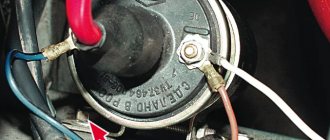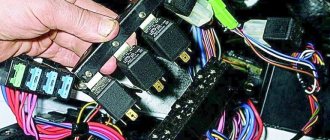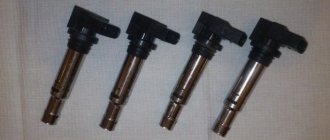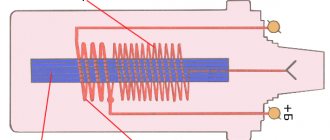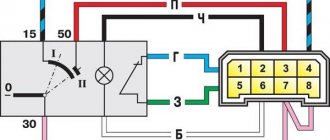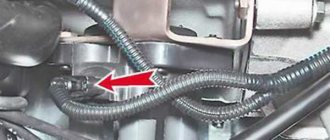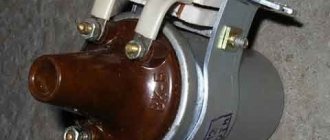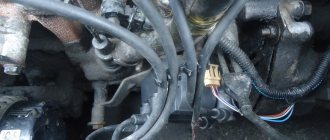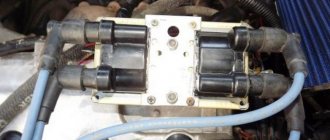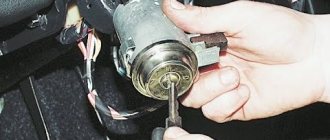The ignition coil is part of the vehicle's ignition system. It converts the 12 volt battery voltage to high voltage to create a spark in the spark plug. The spark ignites the air-fuel mixture in the engine cylinders.
Most modern cars have an individual (plug) ignition coil per cylinder. Usually it is installed directly above the spark plug, as on this VAZ engine in the photo.
In some vehicles, the ignition coils for all cylinders are combined into one coil pack. In older cars with a distributor (distributor), one coil is used for all cylinders. Check out this example of an engine with a single ignition coil:
Ignition system diagram
In the general scheme of the ignition system, the coil is located between the battery and the ignition distributor, followed by spark plugs. A breaker (in old cars) or an ECU is connected in parallel with the coil to regulate the charge supply - in new ones. A direct low-voltage current from the battery (or generator) is supplied to the coil. The breaker handles periodic breaks in the circuit (more on this a little later, in the description of the operating principle). The coil generates a high-voltage current, which is supplied to the desired spark plug through a distributor. Regardless of what control system is used in the car (mechanical or electronic), the ignition circuit does not change in principle, but is only improved in form.
Scheme of operation of an ignition system with a coil
If any element of the system fails, this immediately affects the operating mode of the engine. That's why the reel is so important.
Signs of breakdown
The reel has a reliable design and its service life is significant. And yet this element can also fail.
The main signs that the ignition coil is not working properly are:
- Inability to start the power plant;
- The inscription “Check Engine” appears on the dashboard (on cars with an ECU), and when scanning the system, code P0363 is displayed, indicating a malfunction of the ignition module (on modern injection cars);
- Decrease in power unit performance;
- Misfires, which causes the engine to “trouble” (with time the problem becomes more pronounced);
- Dips when reaching certain crankshaft speeds.
It should be noted that these malfunctions are also typical for other elements of the ignition system, for example spark plugs, so before you “sin” the coil, you should check the entire circuit coming from it.
Purpose of the ignition coil
Ignition of the fuel-air mixture in the combustion chamber of a gasoline engine is carried out using an electric spark generated by a spark plug. However, it is quite difficult to create a spark of sufficient strength, because gasoline mixed with air is a good dielectric, and it is not easy for even a short spark breakdown to occur in it. The problem can be solved only by applying a powerful electric pulse with a voltage of tens of thousands of volts to the spark plug. Where can you get that kind of voltage in a car, even for a short fraction of a second?
This problem is solved using a special device - an ignition coil, or bobbin. An ignition coil is a component of a vehicle's ignition system that converts low-voltage direct current (6, 12, or 24 volts depending on vehicle type) from the battery or alternator into a short electrical pulse of up to 35,000 volts. The pulse from the coil is supplied to the spark plug, a spark appears in its spark gap, which achieves the goal - ignition of the fuel-air mixture.
Today, ignition coils are used in almost all cars with gasoline engines or gas-powered engines. Reels are used with equal success both in ignition systems of traditional circuits (contact with a distributor, contactless with thyristors) and in modern electronic ignition systems. Because there is no simpler, more reliable and efficient way to create a high-voltage electrical pulse.
How does it work
The principle of operation of the ignition coil is based on the basic physical laws that were taught in school. It can be characterized as follows: a low-voltage type voltage is sent to the primary winding. All this creates a magnetic field. Sometimes this voltage can be cut off by a breaker, which causes a sharp reduction in the magnetic field along with the formation of an electromotive force in the turns of the coil.
If you believe the physical law regarding electromagnetic induction, then the magnitude of the electromotive force that arises in this way is proportional to the number of turns in the circuit winding. This can explain the fact that a high voltage pulse is formed in the secondary coil, because there are a large number of turns there. This impulse is sent to the spark plug. Moreover, this process is not typical for the individual type, since this type is installed directly on the candle.
It is thanks to this impulse, transmitted by a coil, that a spark occurs between the electrodes of the spark plug, which causes the fuel-air mixture to ignite. And at the moment when the occurrence of this spark is simply necessary, the contacts in the distributor-breaker open. At the same moment, the primary winding circuit breaks. A high-voltage current appears at the central contact of the coil, after which it is sent again - to the contact opposite which the slider electrode is located at that particular moment. After all this, the circuit is closed, and the impulse passes to the spark plug belonging to one of the cylinders.
A small recommendation: the coil does not particularly welcome long-term loads, so it is better to turn on the ignition for a long time when the engine does not start. This is a proven fact, the implementation of which will help to maximize the duration of the described mechanism.
Outdated car models had such coils, the voltage from which was supplied to all spark plugs at once using an ignition distributor. The latter mechanism turned out to be not reliable enough, and therefore in modern cars they began to actively use systems with individual coils belonging to each individual spark plug. In this regard, the sparking energy increased, and the level of radio interference created by the ignition system, on the contrary, decreased. Also, the use of this system made it possible to say goodbye to the need to use high-voltage wires, which often turn out to be unreliable.
The coil, as the most important element of the overall ignition system, needs special attention and care. Therefore, this should not be neglected and should be expected until the last moment, until only this mechanism fails, but also the entire ignition system, and later the car. So I recommend that you always find time to carry out at least basic diagnostics of the car and the ignition system in particular, especially if the principle of its operation is now known. And may the car never fail.
Diagram of the operation of an ignition coil in a car
Ignition coil device
The basic design of the coil remains the same for all modifications and design features.
The device of the simplest ignition coil
- Internal central core made of steel plates insulated together to reduce eddy currents.
- The primary winding is made of thick (approximately 0.8 mm in cross-section) wire wound in 250-400 turns.
- The secondary winding, consisting of a thin wire (approximately 0.1 mm in cross-section), wound in 20-25 thousand turns. On average, the ratio of the number of turns between the primary and secondary windings is approximately 1:150 to 1:200.
- Outer ring core, also known as magnetic circuit.
- Terminals: two for low voltage current (from the battery and to ground) and one high voltage.
- Housing, filler (filled with transformer oil or epoxy compound).
The primary and secondary windings are insulated from each other, and in expensive models there is insulation between the layers of turns. This is done in order to avoid voltage breakdowns.
Video: Individual ignition coil VAZ
Something else useful for you:
- What is the heat rating of spark plugs?
- How to choose the best spark plugs?
- How to replace spark plugs?
Since current heating of the windings is possible during operation of the coil, transformer oil is used for cooling, which fills the housing cavity. Its cover fits tightly to the body, so the coil is non-separable. If it malfunctions, it cannot be repaired either.
The input and output voltage of the coil are not the main characteristics with which you can check its serviceability. The performance of the coil is checked by the resistance of its coil. In this case, the resistance of each coil may be different. For example, a coil may have a resistance of the first winding of 3.0 Ohms, and a resistance of the secondary winding of 7000-9000 Ohms. A deviation during measurement from these values will indicate a coil malfunction. And since it cannot be repaired, it is simply replaced.
The design of a general type coil has been described above. It is installed on all cars that have a battery, contactless and electronic ignition system, and are equipped with a distributor that directs the impulse from the coil to the desired cylinder.
Photo gallery
Photos of different types of devices are presented in this section.
Classic machine short circuit
Individual short circuits for each candle
Dual type device
Types of coils
Today, there are a sufficient number of types of ignition coils that can be installed both on old domestic cars with carburetor engines and on more modern cars with direct fuel injection.
Housing ignition coils are installed on vehicles with mechanical ignition distribution, where the distributor, rotating, supplies high-voltage voltage to each spark plug in a certain sequence. This method of switching and voltage distribution is not used in the modern automotive industry due to its short service life and low reliability.
A coil with electronic ignition distribution, or a distribution coil, does not require an additional contact cascade breaker for its operation, because with the development of technology in microelectronics, it has become possible to integrate such an ignition breaker into the coil itself. This coil is suitable for cars with mechanical ignition distribution.
A dual-spark ignition coil allows spark plug voltage to be generated simultaneously in two engine cylinders per crankshaft revolution, without the need for coordination between the ignition system and the camshaft. It is advisable to use such coils only in engines with an even number of cylinders, for example, for an engine with four cylinders you will need two coils, with six - three, respectively, with eight - four.
Double spark ignition coil
The "smart" plug ignition coil is single-spark and is installed directly on each spark plug. The design and functional characteristics of such a coil make it possible to avoid the use of high-voltage wires in the system, but it requires connecting clamps (terminals) designed for high voltage. Due to their compactness, these coils are used in cars with a small amount of free engine compartment space, but compact does not mean ineffective. The plug coil can easily compete with its brothers.
Plug-in ignition coil device
The advantages of the reel are:
- The widest range of ignition timing settings.
- Diagnosis of misfires from the primary and secondary windings.
- Spark extinguishing in the secondary circuit using a high voltage diode.
Such devices are used for engines with any number of cylinders, but synchronization with the position of the camshaft using an appropriate sensor is strictly required.
Design differences between individual coils
This type of coil is used in electronic systems. They work the same way as the classic ones. Its structure also has high and low voltage windings. But there are also differences: in an individual coil, the primary winding is inside the secondary; the presence of two cores - internal and external.
The first is located inside the primary winding. The second one is around the secondary. The high voltage winding of the individual ignition coils is equipped with a special diode. Its purpose is to cut off high voltage currents.
Individual coils are divided into 2 types: compact and rod. They differ in the structure of the core. The latter have the ability to combine 4 pieces. The result of the coil's activity is the formation of one spark in one complete cycle. This explains the need to synchronize all coils relative to the engine camshaft.
Requirements for modern ignition coils
Requirements that apply to all modern short circuits:
- Simplicity of design. The simpler the short circuit is, the easier it is to install and maintain in the future. With a simpler device, the consumer will be able to independently diagnose in case of problems.
- Small dimensions and weight.
- High service life. The reliability of the device will ensure a long service life.
- Reliable protection against humidity and elevated temperatures. It is important that the design of the reel, as well as the materials used for its production, are resistant to elevated temperatures and moisture. This will ensure effective operation of the short circuit when weather conditions change and exposure to the aggressive environment characteristic of the engine compartment. The vapors that come from fuel and engine fluid should not harm the device or its body. If the structure body is damaged, this will lead to a deterioration in the functioning of the short circuit as a whole.
- Precision fit of the device, as well as resistance to short circuits. The design of the short circuit must be made so that its dimensions are sufficient to remove heat and ensure temperature stability.
Technical characteristics of ignition coils
The main characteristics of the devices are shown in the table.
| Characteristic | Description |
| Inductance | This parameter determines the ability of the short circuit to accumulate electricity and is measured in Gn. The energy collected inside the primary element of the device is proportional to the inductance value. The higher the inductance value, the more energy the mechanism can accumulate |
| Transformation parameter | Determines how much a short circuit can increase the magnitude of the primary voltage. The primary element receives 12-volt voltage from the battery, and when the circuit is opened, the current will drop from 6-20 amperes to 0. As a result of the current change, voltage appears on the primary component, and the transformation parameter determines how much this value has increased. This value is determined by the ratio of the number of turns in the secondary and primary devices |
| Short circuit resistance value | The primary coil device has a resistance of about 0.25-0.55 Ohms, and the secondary - from 2 to 25 kOhms. The magnitude of the spark formation power, as well as its energy, is inversely proportional to the resistance parameter in the primary component. The higher this value, the lower the amount of energy and power that is generated when a spark is applied. |
| spark energy | This parameter is about 0.1 joule and is consumed over 1.2 ms. In the spark plug itself, energy appears as a result of the formation of an arc charge when a breakdown occurs between the electrode elements. The voltage value on the parts is determined by the diameter of the spark plug, as well as the gap between the electrode components and the material from which it is made. This value is also affected by the temperature and pressure in the combustion chambers of the internal combustion engine, and the composition of the combustible mixture. For efficient operation of spark plugs, the voltage generated in the short circuit will be one and a half times greater than the voltage required to ensure breakdown |
| Breakdown voltage parameter | The breakdown itself is formed between the electrode components of the spark plug if the voltage across them and the breakdown correspond to each other. The operating parameter is determined by the gap between the electrodes, the pressure parameter in the combustion chambers, as well as the temperature of the combustible composition. When starting the internal combustion engine cold, this value should be greater, this will allow breakdown and the appearance of a spark discharge. This is important because the fuel and air in the engine are still cold. |
| Number of sparks appearing per minute | To calculate the number of sparks in one minute, you need to know the crankshaft speed, as well as the number of cylinders in the internal combustion engine. The spark value can be calculated by dividing the number of revolutions multiplied by the number of cylinders. And divide the resulting indicator by the number of engine cycles |
Causes of malfunctions
Ignition coils are reliable devices and the main reasons for their failure include: insulation breakdown, limiting service life.
Below we list other reasons why a device may fail.
| 1. Aging and mechanical damage. | During operation, the materials from which the ignition coil is made lose their strength, begin to crack and collapse, and various liquids (oil, antifreeze, etc.) can affect the device, which negatively affects its service life. There is only one solution - replacement. |
| 2. Damage or oxidation of the contact connection. | Penetration of moisture under the hood, a humid climate, after fording, improper washing of the engine or car, all this can affect the condition of the contacts and their rapid oxidation. |
| 3. Vibrations. | Individual ignition coils of electronic injection vehicles are very sensitive to vibrations. For example, if the motor is tripping, or one of its supports is out of order, it vibrates strongly. Also, very bad roads, which are not uncommon here, can cause severe shaking and affect the position of the reels. |
| 4. Overheating. | The same applies to individual coils, which are located near the cylinder head, where the temperature is highest. In the intended temperature conditions of the engine operation, nothing will happen, but if, as a result of poor quality coolant or for other reasons, the engine overheats, this will negatively affect the ignition coil as a whole. |
Service life and malfunctions of ignition coils
Theoretically, modern ignition coils have a service life of 60-80 thousand vehicle kilometers. However, actual performance largely depends on operating conditions. There can be many reasons for malfunctions:
- Short circuit on the windings.
- Coil overheating.
- Wear due to long-term use or increased vibration.
- Charging time exceeded. Most often this happens when the car battery does not provide the required voltage level.
- Depressurization of the main components of the engine and fuel system.
- Damage to the body.
In modern cars, the on-board computer signals a coil malfunction by turning on the Check Engine indicator on the dashboard. In addition, signs of malfunction are:
- Deviation of the resistance of the transformer windings from the standard value. Diagnosed using a tester.
- Intermittent or complete failure of one or more engine cylinders, reducing engine power.
- Deterioration of internal combustion engine performance in cold (frosty) weather or high air humidity.
- Engine failure when the gas pedal is suddenly pressed.
- Poor vehicle acceleration.
Due to the design features, repairing ignition coils is impossible, and if problems are detected, they are simply replaced with new ones. It is better to diagnose the condition and replace them in service centers, since the operation of the engine and the vehicle as a whole depends on the accuracy of the operation of this element of the ignition system.
Video “Self-diagnosis of short circuit operation”
The MotoDalnoBoy channel talked about the causes of malfunctions and also showed ways to check the coil using a tester.
Tips for use
Here are some tips to help extend the life of your ignition coil.
- Make sure that all elements of the on-board electrical network are in good working order. Any deviation from the norm can “kill” a part: voltage surges in the battery, violation of the integrity of the high-voltage cable, incorrect functioning of the control unit.
- Don't buy candles that are too cheap. They have a weak seal, which can lead to exhaust gas breakthrough. If individual coils are used, this will directly affect their performance by increasing the temperature in the winding area, which can lead to overheating and damage to its integrity. It is better to buy a more expensive model - this will protect other elements of the electrical network from damage.
- Check the device with a multimeter not only when it indicates a malfunction. Carry out preventative measurements regularly. Sometimes a breakdown begins with a slight change in resistance, which does not manifest itself in any way. In the future, this can lead to overheating and more noticeable problems.
- Use standard mounts to install the device. Do not place any additional devices near it that are not provided for by the engine design. All this can lead to poor ventilation and overheating. And this, in turn, leads to burnout of the insulation or wire in the winding.
- Make sure that the body of the device always remains clean. Contaminants also negatively affect the device's ability to transfer heat and can cause significant overheating.
If the device is working properly, but the driver still feels like the engine starts slowly, you can purchase a model with better performance that produces a higher voltage.
Replacing the ignition coil
If the coil malfunctions and cannot be restored, it must be replaced. You can buy exactly the same original one, or you can choose a similar one, but their characteristics should not differ by more than 20-30 percent, and also have the same fastening and design. For example, for domestic cars VAZ-2108 - 2109 with electronic coils 27.3705 from a domestic manufacturer, coils 0.221.122.022, which are not much different in parameters, are suitable. In this case, the spread of parameters will be from 10 to 15%.
To summarize, it can be noted that when writing the article, real information was used about the problems that each driver faced. All coils are practically the same from each other in terms of their operating principle, but not all of them are interchangeable, for example, coils with mechanical ignition distribution cannot work with contactless distribution and vice versa.
Finding the origin of the problem
First you need to check the performance of the spark plugs, and this check may indirectly indicate a coil malfunction.
To check, you just need to unscrew the spark plugs, insert them into the tips of the high voltage wires, massage them and turn the crankshaft several times with the starter. In this case, you should look at the spark that forms between the electrodes.
If it is discovered that a spark plug is not working correctly and the spark in it is formed intermittently, it should be replaced and a known good one installed in its place.
If a working spark plug works intermittently, check the high voltage wire.
If the interruptions persist even when the wire is replaced, then in carburetor cars the distributor is inspected next, and only then the coil.
In injection cars equipped with a module, there is no such distributor, so you can immediately start checking the module.
Checking these elements will not be particularly difficult, and the only equipment you will need is a multimeter with the ability to operate in ohmmeter mode, with a measurement range of up to 200 MOhm.
To make it more clear, let’s look at how these ignition elements are checked on different cars.
Conclusion
One of the important components in a car is the bobbin, which creates high voltage to produce a spark. If dips appear in the engine’s operation, it begins to stall and simply run unstably – this could be the cause. Therefore, it is important to know how to check the ignition coil correctly, and if necessary, using the old-fashioned method, in the field.
Sources
- https://VazNeTaz.ru/katushka-zazhiganiya
- https://www.avtoall.ru/article/4555827/
- https://AvtoMotoProf.ru/obsluzhivanie-i-uhod-za-avtomobilem/chto-iz-sebya-predstavlyaet-katushka-zazhiganiya-avtomobilya/
- https://SwapMotor.ru/ustrojstvo-dvigatelya/katushka-zazhiganiya.html
- https://avtozam.com/elektronika/pusk/printsip-raboty-katushki-zazhiganiya/
- https://TechAutoPort.ru/dvigatel/sistema-zazhiganiya/katushka-zazhiganiya.html
- https://ZnanieAvto.ru/fire/katushka-zazhiganiya-sxema-ustrojstvo-i-podklyuchenie.html
Basic Verification Approach
Since the windings play a key role in the operation of ignition coils, the first thing that needs to be checked, regardless of the type of device, is their resistance.
Thus, the resistance indicators of the primary winding can vary according to different data:
- from 0.6 to 4 Ohm;
- from 0.5 to 3.5 Ohm.
Secondary:
- from 6 to 15 kOhm;
- from 3 to 11 kOhm.
The indications are different because they can be different for each car model, so it is important to study the documentation for the car and the technical characteristics of the coil itself.
It is also important to understand that for each type of coil, indicators such as the inductance of the primary winding, the resistance of both windings, energy, duration and spark current may differ.
Measurements are performed with a multimeter or a regular ohmmeter.
If there is a strong deviation from the standard data, the ignition coil is most likely damaged. But there is no need to rush to change it; there are other ways to check.
Testing the ignition module on a VAZ-2110 injector
On injection cars, for example, VAZ-2110, the module check is performed slightly differently.
The check sequence is as follows:
- We inspect the module for damage. Even small cracks can cause a module to fail, if not now, then in the near future. Therefore, such a module does not need to be checked, but replaced immediately.
- Disconnect the block of wires going to the module. First, check the voltage supply to the module. To do this, switch the multimeter to voltmeter mode, connect one of its probes to terminal “A” (the letters are stamped on the block), and the second to “ground” and turn on the ignition. If the wiring is good, the voltmeter should show 12 V or close to it.
- Then we take a 12 V test light and connect it to terminals “A” and “B” on the block. Then we turn on the starter and look at the “control”; it should blink when the starter is running.
- We switch the multimeter to ohmmeter mode with the measurement parameter in kOhm and measure the resistance of the secondary winding of the coil at the paired terminals. To do this, we connect one probe to the terminal that supplies an impulse to cylinder 1, and the second to the terminal of cylinder 4. A working module should have a resistance of about 5,4
kOhm - We take another measurement, but now on terminals 2 and 3 of cylinders. The readings at these terminals should be normal. A strong discrepancy in resistance at paired terminals indicates a module malfunction and the need for repair or replacement.
Features of choice
On the VAZ 2106 you can find the following types of ignition coils:
- B117: Transformation coefficient – 78.5, Design features – R, M
- 3705: Transformation ratio – 82, Design features – R, M
- 3705: Transformation coefficient – 80, Design features – Z, S.
P – open magnetic circuit; Z – closed magnetic circuit; M – oil-filled coil; C – dry coil; E – shielded coil; DR - the coil has additional resistance
The design of classic VAZ cars does not place excessive demands on the ignition coil. The coil must meet certain parameters and produce the required voltage.
Photo: New ignition coil for VAZ 2106 in packaging
On the VAZ 2106 you can install coils from the following manufacturers:
- ERA is a domestic manufacturer of components for various cars, offering ignition coils for the VAZ 2106 starting at RUB 1,350. Such coils have a very limited service life.
- MZATE-2 offers reliable ignition coils at prices starting from 600 rubles. In addition to the low price, the products are easy to install and are available in almost every car dealership.
- Bosch is a trusted manufacturer of auto parts. Despite the high price (from 2,700 rubles), German-made coils are extremely reliable and have the longest service life.
- SOATE is another domestic manufacturer that sells ignition coils for the VAZ 2106 at prices starting from 700 rubles.
Usually, VAZ 2106 owners, when purchasing, look for powerful coils at a low price, since the power characteristics of the engine directly depend on the number of turns of the winding.
